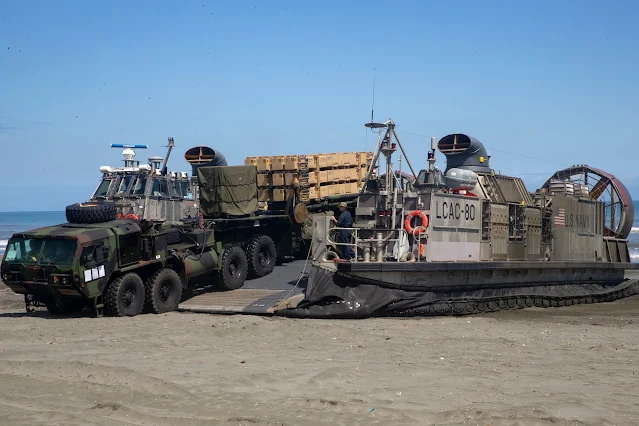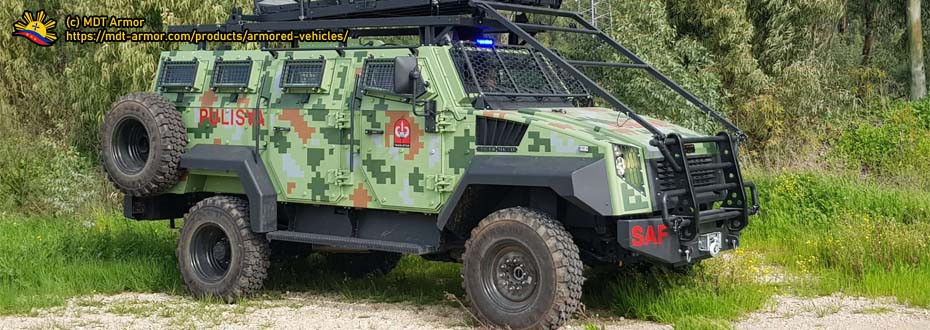Annually, both the Philippine Armed Forces and their counterparts from the United States Armed Forces have joined in conducting in an annual bilateral exercise aiming in improving camaraderie, interoperability, and relations between both alliances that these nations foster, along with its diplomatic tensions amidst a rising China.
Here are the highlights for this year's Joint Exercise Balikatan 2022, Part 1 (covering March 28 to April 2).
NEWS
 |
| A Patriot Missile Mobile Launcher equipped with PAC-3 Canisters disembarked from the Landing Craft Air Cushion as part of the amphibious activities involving air defense system assets as part of the US-Philippine Joint Exercise Balikatan 2022. (c) Defense Visual Information Distribution Service. |
This year marks the 37th US-Philippine Joint Exercise Balikatan, the largest joint military activity that will conduct to date, wherein it will be involve almost 9,000 combined personnel taking part from both the Philippine and the United States Armed Forces, spanning multiple locations situated across the country and involves a different series of various programs and showcase different capability enhancements.
The exercise conducts annually to improve and enhance force capability of both Armed Forces, and enhancing cooperation on different military scenarios such as in conducting amphibious operations, maritime security, live fire training, counterterrorism, and subject mater exchanges in skills and capability that both sides share and work together, while fostering improved relations with the 1951 Mutual Defense Treaty as the foundation.
With the focus primarily on this year's largest bilateral exercises, let us provide each activity that both Armed Forces have conducted throughout the first six days of the 12-day exercise that has kick-start last Monday, March 28, 2022 and will end at Friday, April 8, 2022, as troops and equipment of the United States Armed Forces pour in the country for the initiation of the different activities covered by this bilateral exercise.
ARRIVAL
 |
| A U.S. Air Force C-17 Globemaster assigned to the U.S. Pacific Air Forces starting a final approach into the Subic Bay International Airport last March 19. (c) Defense Information Visual Distribution Service. |
Last March 19 (Saturday), the United States Air Force's C-17 Globemaster and C-130 Cargo Aircrafts arrived into the Subic Bay International Airport, bringing with them troops and equipment that is needed for the exercise that is set nine days from their arrival in the Philippine soil, preparing the necessities that ensure the success of the joint exercise of both alliances.
Their arrival is also being augmented by the MV-22B Ospreys of the United States Marine Corps assigned to the Marine Medium Tiltrotor Squadron 363 or VMM-363 (assigned in Marine Corps Station Hawaii), in which they also brought with them their troops and equipment required for the joint exercise, giving and gaining additional experience in interoperability with their Philippine counterparts in this activity.
Speaking of the Marine Medium Tiltrotor Squadron 363 or the VMM-363, their flight to the Philippines from Guam served as 'one of the longest maritime VMM self-deployment flights in 1st Marine Aircraft Wing history', proving the capabilities of their MV-22B Ospreys in conducting such a lengthy flight, a show of how fully capable United States Armed Forces' logistics chain is in carrying all necessities in areas needed, whether in combat or in a bilateral joint activity like the Balikatan Exercise.
From March 19 to March 26, the United States Armed Forces got a timeline for them to prepare for the largest Balikatan Exercise dated, gathering all the needed materials and personnel that will take part in this bilateral activity, with the highest regard in the exchange of knowledge and experiences in military capabilities and combat, as well as the aim of improving relations of both countries and interoperability of their respective Armed Forces.
The United States Armed Forces' arrival to the country provided that preparedness that will set the activities of their forces and those for the Armed Forces of the Philippines, wherein the bilateral exercise came with different activities that have started in the first six days of the 12-day long military games and enhancements, discussing in the succeeding sub-topics of this article.
USS MIGUEL KEITH AND FLIGHT OPERATIONS
 |
| An AH-1Z Viper of the United States Marine Corps conducting Flight Operations onboard USS Miguel Keith. (c) Defense Visual Information Distribution Service. |
Just off the coast of the country, a United States Navy Expeditionary Mobile Base Ship starts its flight operations that involve AH-1Z Viper Attack Helicopters, UH-1Y Venom Combat Utility Helicopters, and Sikorsky CH-53 Sea Stallion Heavy Lift Helicopters of the United States Marine Corps, wherein it involves logistical airlift requirements from ship to shore.
Given its background, the USS Miguel Keith (ESB-5) is a Lewis B Puller-class Expeditionary Sea Base, which is a relatively new ship that was laid down January 30, 2018 in a General Dynamics facility stationed in San Diego, California, and it got delivered to the United States Navy more than a year later on November 15, 2019. It took two more years until it has commissioned to the United States Navy fleet last year (May 8, 2021).
The ship's deployment provides logistics support for the U.S. troops and military assets that take part in the year's largest bilateral exercise to date, and may count as one of the first for the USS Miguel Keith in participating in this military activity between the United States and the Philippines, especially that it counts as one of the newest vessels that serve the United States Navy fleet in its continuous military operations across the world.
The synchronization between the said ships has to provide the sufficient amphibious support and logistics capabilities that the United States Navy showcased in this exercise, especially this operation now includes a procedure that involves the insertion and deployment of a capable and complex air defense system from ship to shore, aiming to provide support between alliances in aiming to have a secured air defense umbrella.
FIRST PAC-3 PATRIOT MISSILE DEPLOYMENT TO THE COUNTRY
 |
| Amphibious Assault now includes deploying a battery of Patriot Missile Air Defense System from ship to shore. (c) Defense Visual Information Distribution Service. |
Through the years, the Balikatan Exercise primarily focuses on amphibious operations that are limited to amphibious vessels, landing dock ships and marine personnel deployed from ship to shore, if not combined arms live fire exercise, or the not-so-discussed community aid and help on a small village near the combat practice sites that both the United States and Philippine militaries take part.
However, for this year's exercise, it will be a first time incidence that the United States Armed Forces will have an amphibious operation that involves a Patriot Missile Air Defense System landed on the beach, and for it to be deployed further in land, giving a significant portion of air defense for the Philippine airspace that augments the Philippine Air Force's SPYDER Ground-Based Air Defense System.
While there is a long way to go for the Armed Forces of the Philippines regarding its efforts to improve its air defense as part of enhancing and further enforcing the defense of the country's Philippine Air Defense Identification Zone or PADIZ, an extra help from an ally in an event of a conflict like getting an air defense system landed on the beaches and getting deployed further in-land serving as reinforcement is appreciable, particularly as escalations from a regional power threatens the balance of order in the region.
COMBINED ARMS LIVE-FIRE EXERCISE
 |
Four M142 High Mobility Artillery Rocket System or better known as HIMARS, deployed in Crow Valley Gunnery Range, Colonel Ernesto Ravina Air Base in Capas, Tarlac.
(c) Defense Visual Information Distribution Service. |
One of the primary highlights of this whole 2022 Balikatan Exercise, the Combined Arms Live-Fire Exercise, comes with the most amount of firepower unleashed, ranging from ammunition coming off from Close Air Support Aircraft down to the artillery barrage provided by Multiple Launch Rocket Systems such as the four units of M142 High Mobility Artillery Rocket System or HIMARS, as seen in an image above.
Aside from these sophisticated HIMARS that the United States Army deployed, other military assets that took part in this exercise include the AH-64 Apache Helicopter of the United States Armed Forces, A-29 Super Tucano Close Air Support Aircraft of the Philippine Air Force, CH-47 Chinook Helicopters of the United States Army, RCWS-equipped M-113s of the Philippine Army, several Humvee vehicles of the United States Army, UH-60 Blackhawk Helicopters, and military troops taking part from both sides.
As the Armed Forces of the Philippines modernize further, with the Horizon 3 getting implemented from 2023 to 2028, it will not be surprising that they will employ newer and more capable military assets in this exercise, as the whole point of it getting conducted is the interoperability of capabilities between both the Philippine and the United States Armed Forces, and to have a proper coordination between military units of both nations in an event that a conflict arise in the region.
BILATERAL AMPHIBIOUS LANDING AT CLAVERIA
 |
| Troops from the Philippine Marine Corps (PMC), seen disembarking from the brand new S-70i Blackhawk Helicopter of the Philippine Air Force. (c) Defense Visual Information Distribution Service. |
Another highlight for this exercise is the Amphibious activity in Claveria, province of Cagayan, in Northern Luzon area with roughly 600 kilometers from the island nation of Taiwan, which faces the threat of invasion from the communist People's Republic of China and its forces from the People's Liberation Army, along with its naval branch and air force branch.
In this simulation, the Armed Forces of the Philippines deployed many newer assets that are mentioned, especially that all of it resulted from the ongoing modernization program that will last until 2028 under Republic Act 10349, wherein these military hardware were basically nonexistent more than a decade ago, and the Philippine military troops typically riding along U.S. Military hardware at the early years of implementing the Balikatan Exercise.
Aside from that, both countries are benefiting in the interoperability, camaraderie, and, of course, the subject exchanges and military experiences between both Armed Forces as the troops that have taken part in the activity have learned a lot regarding getting together in the times of combat and also at the times of peace, especially now that chances of a heated conflict in the region is getting more likely through time.
Hence, this joint exercise is a friendly gesture of a growing military and diplomatic relationship between the Philippines and the United States, especially that both nations celebrate the 75 years of diplomatic relations since the former's independence from the latter, and also the 70th anniversary of the bilateral-agreed 1951 Mutual Defense Treaty that ensures the security and cooperation between both countries.
TO SURMISE THIS UP
 |
| A United States Air Force F-16 Multirole Fighter Jet took off from the runway of Basa Air Base in Pampanga. (c) Defense Visual Information Distribution Service. |
The events that were discussed in this article are just some of the military activities that both the Philippine Armed Forces and their counterparts from the United States Armed Forces have conducted throughout the first part of the whole Joint Exercise Balikatan 2022, as there are more events to be covered on the second part of this article series, such as the Air Defense Training Mission exercise that involves military assets such as the F-16s (see image above).
Even with the events discussed all throughout this webpage, we can say that there are many things that took place, wherein it significantly help improves the diplomatic and military relationship between the Philippines and the United States, along with the importance of the former as part of the defense efforts of the latter in assuring the peace and stability in the region, particularly against the rise of another regional power like the People's Republic of China.
With the number of military personnel from both of the country's armed forces took part, along with the number of firsts that this year's Balikatan Exercises executed such as the deployment of Patriot Missiles north of the country, is a gesture that shows the alliances' resolve in adapting of ever-changing nature of threats, particularly that it took place in the area that is nearest to the island country of Taiwan, itself faced the threat of a Chinese invasion.
With from the resolve and the threats mentioned, the Joint United States-Philippine Exercise Balikatan 2022 gets more relevant than ever, as it may get the chance of increasing the number of military participants than the largest one it has to date, as well as the increasing use of various military hardware on both sides that emphasizes that interoperability that this exercise aims to have, alongside the increasing friendship and camaraderie between Philippine and U.S. troops.
To sum it up, the highlights of the exercise showcase the active participation of both sides regarding the different scenarios shown, from the sea to the shore, in the land and in the air, as well as in giving support to communities, in which several of these activities are to be covered in the second part of the article series, featuring this year's joint exercise between allies bound by the 1951 Mutual Defense Treaty.






















.png)



